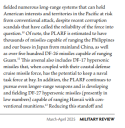China Should be able to increase range of DF-27 HGV without altering fundamental aerothermodynamic design aspects through a variety of means. For example by developing utra high bandwidth control alone (increasingly possible with ever increasing computational power) that provides:
1. Sufficient stability to the glide vehicle with required flight control authority at higher upper atmosphere ( Lower flight dynamic control).
2. Minimizing energy losses by developing higher level control algorithms, that generate near real time optimal flight path that finds best compromise as far as need to avoid detection, tracking, impact point prediction by enemy is concerned while also respecting glide vehicle's fundamental operational/design limitations (e.g. error propagation not just due to sensor and control response uncertainties but also due to alteration in vehicle dynamic characteristics due to uncertain impact of heat transfer, permanent or extremely slowly recovering elasto-plastic micro-geometry changes due to aero-thermal loads along the flight path as well as due to reliability and quality control issue and so on). With enough computational and flight test data, one can develop more advanced data driven digital twins models that more accurately reflect actual flight vehicle (rather than the theoretically, computational or previously data drivenly envisioned one) allowing more advanced data driven optimization of flight paths, control systems, some changes in subsystems that almost always will lead to better range and better other things. Meaning even when a flight vehicle is operational, a determined team can furhter optimize the flight vehice without too many changes in the existing design.
Also slight or not so slight re-optimization by small changes in aerodynamics (aerothermodynamics) , structural and other design aspects should also increase the range with some negligible loss in final speed and/or in-flight agility.
Furthermore, allowing some actual tolerable energy loss without significant decrease in speed in mid or terminal flight regions, can add to the already designed range.
The point is like subsonic or supersonic flight, there are always options in hypersonic flight vehicles that allow final range enhancements without lowering the payload.
I see no reason current DF-27 HGV range is final one. It likely is being improved with better control and guidance algorithms along with other aspects such as the ones discussed above. Other countries improve exiting flight and control aspects. China likely does more of that than other nations. Its a very safe bet.

